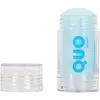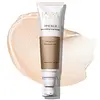What's inside
What's inside
 Key Ingredients
Key Ingredients

 Benefits
Benefits

 Concerns
Concerns

 Ingredients Side-by-side
Ingredients Side-by-side

Water
Skin ConditioningButylene Glycol
HumectantPropylene Glycol
HumectantGlycerin
HumectantSodium Stearate
CleansingBis-PEG-18 Methyl Ether Dimethyl Silane
EmollientCamellia Sinensis Leaf Extract
AntimicrobialAloe Barbadensis Leaf Juice
Skin ConditioningPhenoxyethanol
PreservativeHamamelis Virginiana Extract
AntiseborrhoeicCaprylyl Glycol
EmollientEthylhexylglycerin
Skin ConditioningCI 42090
Cosmetic ColorantWater
Skin ConditioningBis-PEG-18 Methyl Ether Dimethyl Silane
EmollientGlycerin
HumectantAluminum Starch Octenylsuccinate
AbsorbentButylene Glycol
HumectantSilica
AbrasivePvp
Emulsion StabilisingAcrylates/C10-30 Alkyl Acrylate Crosspolymer
Emulsion StabilisingAminomethyl Propanol
BufferingAmmonium Acryloyldimethyltaurate/Vp Copolymer
Sodium Hyaluronate
HumectantMica
Cosmetic ColorantPPG-26-Buteth-26
Skin ConditioningPEG-40 Hydrogenated Castor Oil
EmulsifyingMethylpropanediol
SolventCaprylyl Glycol
EmollientPhenylpropanol
MaskingCaprylic/Capric Triglyceride
MaskingCrithmum Maritimum Extract
Skin ConditioningHydroxyethyl Acrylate/Sodium Acryloyldimethyl Taurate Copolymer
Emulsion StabilisingSynthetic Fluorphlogopite
Squalane
EmollientPolysorbate 60
EmulsifyingAlumina
AbrasiveSorbitan Isostearate
EmulsifyingPropylene Glycol
HumectantHamamelis Virginiana Leaf Extract
Skin ConditioningCamellia Sinensis Leaf Extract
AntimicrobialAloe Barbadensis Leaf Juice
Skin ConditioningPotassium Sorbate
PreservativeSodium Benzoate
MaskingCentella Asiatica Leaf Extract
Skin ConditioningChamomilla Recutita Flower Extract
MaskingOryza Sativa Lees Extract
Skin ConditioningSodium Citrate
BufferingCitric Acid
BufferingLaminaria Ochroleuca Extract
Skin ConditioningSaxifraga Sarmentosa Extract
Skin ConditioningVitis Vinifera Fruit Extract
Skin ConditioningMorus Alba Root Extract
BleachingScutellaria Baicalensis Root Extract
AstringentDisodium EDTA
BHT
AntioxidantPhenoxyethanol
PreservativeEthylhexylglycerin
Skin ConditioningSodium Sulfite
PreservativeSodium Metabisulfite
AntioxidantAlaria Esculenta Extract
Skin ProtectingAster Tripolium Extract
Skin ProtectingCI 77891
Cosmetic ColorantCI 77491
Cosmetic ColorantCI 16035
Cosmetic ColorantCI 19140
Cosmetic ColorantWater, Bis-PEG-18 Methyl Ether Dimethyl Silane, Glycerin, Aluminum Starch Octenylsuccinate, Butylene Glycol, Silica, Pvp, Acrylates/C10-30 Alkyl Acrylate Crosspolymer, Aminomethyl Propanol, Ammonium Acryloyldimethyltaurate/Vp Copolymer, Sodium Hyaluronate, Mica, PPG-26-Buteth-26, PEG-40 Hydrogenated Castor Oil, Methylpropanediol, Caprylyl Glycol, Phenylpropanol, Caprylic/Capric Triglyceride, Crithmum Maritimum Extract, Hydroxyethyl Acrylate/Sodium Acryloyldimethyl Taurate Copolymer, Synthetic Fluorphlogopite, Squalane, Polysorbate 60, Alumina, Sorbitan Isostearate, Propylene Glycol, Hamamelis Virginiana Leaf Extract, Camellia Sinensis Leaf Extract, Aloe Barbadensis Leaf Juice, Potassium Sorbate, Sodium Benzoate, Centella Asiatica Leaf Extract, Chamomilla Recutita Flower Extract, Oryza Sativa Lees Extract, Sodium Citrate, Citric Acid, Laminaria Ochroleuca Extract, Saxifraga Sarmentosa Extract, Vitis Vinifera Fruit Extract, Morus Alba Root Extract, Scutellaria Baicalensis Root Extract, Disodium EDTA, BHT, Phenoxyethanol, Ethylhexylglycerin, Sodium Sulfite, Sodium Metabisulfite, Alaria Esculenta Extract, Aster Tripolium Extract, CI 77891, CI 77491, CI 16035, CI 19140
Ingredients Explained
These ingredients are found in both products.
Ingredients higher up in an ingredient list are typically present in a larger amount.
Aloe Barbadensis Leaf Juice comes from leaves of the aloe plant. Aloe Barbadensis Leaf Juice is best known for helping to soothe sunburns. It is also anti-inflammatory, moisturizing, antiseptic, and can help heal wounds.
Aloe is packed with good stuff including Vitamins A, C, and E. These vitamins are antioxidants, which help fight free-radicals and the damage they may cause. Free-radicals are molecules that may damage your skin cells, such as pollution.
Aloe Barbadensis Leaf Juice also contains sugars. These sugars come in the form of monosaccharides and polysaccharides, folic acid, and choline. These sugars are able to help bind moisture to skin.
It also contains minerals such as calcium, 12 anthraquinones, fatty acids, amino acids, and Vitamin B12.
Learn more about Aloe Barbadensis Leaf JuiceBis-Peg-18 Methyl Ether Dimethyl Silane belongs to the siloxanes and silicones classes. It is synthetically created and has a waxy composition.
This ingredient is a humectant and emollient, meaning it helps hydrate the skin. Humectants draw moisture to your skin, while emollients prevent moisture from escaping.
Butylene Glycol (or BG) is used within cosmetic products for a few different reasons:
Overall, Butylene Glycol is a safe and well-rounded ingredient that works well with other ingredients.
Though this ingredient works well with most skin types, some people with sensitive skin may experience a reaction such as allergic rashes, closed comedones, or itchiness.
Learn more about Butylene GlycolCamellia Sinensis Leaf Extract is derived from the leaves of the tea plant. Black tea, green tea, and oolong tea are all harvested from this plant.
This ingredient has many skin benefits:
This ingredient contains polyphenols, a strong antioxidant. Antioxidants help fight off molecules that damage skin cells.
On top of that, the antioxidants in green tea neutralize free-radicals from the sun. This gives the skin some extra UV protection, but should not replace sunscreen.
Many components of tea have anti-inflammatory properties.
Polyphenols and L-theanine help soothe the skin and reduce irritation. The caffeine in Camellia Sinensis Leaf Extract helps calm inflamed blood vessels.
Other compounds found in tea include: Vitamin Bs, linoleic acid, magnesium, calcium, iron, and zinc.
Research has shown both drinking Camellia Sinensis Leaf Tea and applying it to the skin can help boost skin elasticity and hydration. Studies also show using tea extract may reduce sebum, or oil, production.
Learn more about Camellia Sinensis Leaf ExtractCaprylyl Glycol is a humectant and emollient, meaning it attracts and preserves moisture.
It is a common ingredient in many products, especially those designed to hydrate skin. The primary benefits are retaining moisture, skin softening, and promoting a healthy skin barrier.
Though Caprylyl Glycol is an alcohol derived from fatty acids, it is not the kind that can dry out skin.
This ingredient is also used as a preservative to extend the life of products. It has slight antimicrobial properties.
Learn more about Caprylyl GlycolEthylhexylglycerin (we can't pronounce this either) is commonly used as a preservative and skin softener. It is derived from glyceryl.
You might see Ethylhexylglycerin often paired with other preservatives such as phenoxyethanol. Ethylhexylglycerin has been found to increase the effectiveness of these other preservatives.
Glycerin is already naturally found in your skin. It helps moisturize and protect your skin.
A study from 2016 found glycerin to be more effective as a humectant than AHAs and hyaluronic acid.
As a humectant, it helps the skin stay hydrated by pulling moisture to your skin. The low molecular weight of glycerin allows it to pull moisture into the deeper layers of your skin.
Hydrated skin improves your skin barrier; Your skin barrier helps protect against irritants and bacteria.
Glycerin has also been found to have antimicrobial and antiviral properties. Due to these properties, glycerin is often used in wound and burn treatments.
In cosmetics, glycerin is usually derived from plants such as soybean or palm. However, it can also be sourced from animals, such as tallow or animal fat.
This ingredient is organic, colorless, odorless, and non-toxic.
Glycerin is the name for this ingredient in American English. British English uses Glycerol/Glycerine.
Learn more about GlycerinPhenoxyethanol is a preservative that has germicide, antimicrobial, and aromatic properties. Studies show that phenoxyethanol can prevent microbial growth. By itself, it has a scent that is similar to that of a rose.
It's often used in formulations along with Caprylyl Glycol to preserve the shelf life of products.
Propylene Glycol is an odorless, colorless liquid. As a humectant, it helps skin retain moisture. It also aids in delivering active ingredients.
Another role of this ingredient is preventing a product from melting or freezing. Propylene glycol also adds antimicrobrial properties to a product, elongating product lifespan.
This ingredient is considered an organic alcohol and commonly added into both cosmetics and foods.
Those with sensitive skin or conditions may develop a rash when using this ingredient.
Learn more about Propylene GlycolWater. It's the most common cosmetic ingredient of all. You'll usually see it at the top of ingredient lists, meaning that it makes up the largest part of the product.
So why is it so popular? Water most often acts as a solvent - this means that it helps dissolve other ingredients into the formulation.
You'll also recognize water as that liquid we all need to stay alive. If you see this, drink a glass of water. Stay hydrated!
Learn more about Water